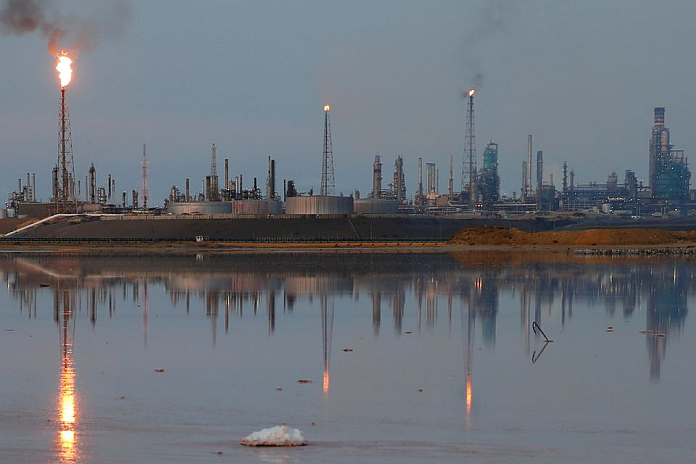CARACAS, Venezuela, (venezuelanalysis.com) – Venezuela continues struggling to sustain oil and fuel output following operational disruptions in crude upgraders and blending stations.
According to the latest Organization of Petroleum Exporting Countries (OPEC) report, the Caribbean nation pumped 678,000 barrels per day (bpd) in August, similar to July’s 672,000 bpd, as measured by secondary sources.
For its part, Venezuelan state oil company PDVSA registered a higher figure with 723,000 bpd, surpassing the previous month’s 629,000 bpd. In the first half of 2022, Caracas had maintained a steady growth reaching an average of 760,000 bpd.
However, frequent mechanical failures as well as power outages and gas disruptions have slowed down operations in recent months. According to Reuters, PDVSA was forced to stop three upgraders located in the eastern Orinoco Oil Belt in recent weeks. Some facilities have allegedly restarted but no details have been provided by authorities.
Venezuela depends on crude upgraders, which are mostly operated by joint ventures with foreign companies, to convert the extra-heavy oil produced in the Orinoco Belt into exportable grades.
The decline in production likewise follows halted operations in the Petroboscán joint venture in Zulia state, which has been offline since June 8, according to Argus Media. The stoppage has caused the country’s western crude output to drop from around 150,000 to 98,500 bpd in August, Gas Energy reported.
A source told reporters there is no date for Petroboscán to restart, citing a range of structural issues. The facility’s crude production is mostly used for manufacturing asphalt.
Petroboscán is one of four joint ventures between PDVSA and US corporation Chevron, which together used to run at a 200,000 bpd capacity before US sanctions forced the California-based company to wind down operations in the Caribbean country.
Earlier this month, Chevron reportedly requested the US Treasury Department grant a broader license to take greater control of its joint ventures in Venezuela. The corporation is seeking a crude-for-diluents swap deal that will boost production at the Petropiar crude upgrader and to sell Venezuelan oil in order to offset a reported $3 billion owed by PDVSA. For its part, Caracas has stated that “the ball is in the US’ court.”
For their part, Italy’s Eni and Spain’s Repsol obtained authorizations for oil-for-debt swap deals with Caracas in May. The two corporations carried several cargoes in June and July before shipments were reportedly suspended as PDVSA looks to expand business terms and receive fuel as well.
Since 2017, Venezuela has been under crushing US sanctions when Washington imposed financial measures against PDVSA. This was followed by a full-fledged oil embargo in 2019, secondary sanctions and a raft of other measures. As a result, crude output fell to historic lows, going from 1.9 million bpd in 2017 to less than 500,000 bpd by the end of 2020.
With Washington’s sanctions limiting the markets that can receive Venezuelan oil as well as recurring operational disruptions, the South American country’s exports have ebbed and flowed this year. In May, the country shipped 391,452 bpd of crude and fuel, the lowest level since October 2020. June saw a moderate recovery with 630,500 bpd which decline again to 460,323 bpd in July. Reduced shipments have led to mounting inventories of 10.7 million barrels, while below-market-price Russian exports have likewise affected PDVSA’s prospects in Asian markets.
In August, exports rose again with 32 cargoes departing from Venezuelan ports carrying 760,710 bpd of crude and refined products and around 256,000 bpd of byproducts, according to Refinitiv Eikon. Sales were boosted by more shipments of oil fuel, methanol and petroleum coke (petcoke) to Indian companies.
Most shipments were bound for China, the main destination for Venezuelan oil in recent years following Beijing’s maneuvers to circumvent US sanctions via intermediary traders. Last week, the Asian ally reportedly struck a new deal with Caracas for a defense firm to take crude as payment to offset the Latin American country’s billions of dollars of debt.
“The cooperation meets Venezuela’s current needs and is also in line with humanitarian principles,” a Chinese foreign ministry spokesperson said to reporters.
Additionally, Venezuela’s fuel refining circuit has been hit by a number of operational difficulties. On September 11, the Cardón refinery in the western Falcón state suffered an electrical failure and production has been paralyzed since then. This setback follows a 3-month maintenance disruption in the naphtha reformer unit.
The Cardón refinery is the second largest in the country with a capacity to process 310,000 bpd into gasoline, diesel and domestic gas. The facility is part of the 955,000 bpd-Paraguaná Refining Complex (CRP), the largest in the hemisphere.
Meanwhile, the 146,000 bpd El Palito refinery in Carabobo state has been out of service as well since the end of 2021 following alleged terrorist attacks and other issues.
Venezuela’s Western-designed refineries have suffered from lack of maintenance as US sanctions continue blocking purchases of key parts for repair works. In October 2020, Washington shut down swap deals which had seen PDVSA exchange crude for diesel, gasoline or diluents needed for refining. As a result, the country has faced fuel shortages, affecting mostly rural production and public transportation.
For its part, the Maduro government has turned to Iran for assistance to jumpstart the oil industry. Since 2020, Tehran has helped Venezuela meet its fuel needs by sending several gasoline cargoes as well as diluents, equipment, materials and technicians to restart operations.
In early June, President Maduro and his Iranian counterpart Ibrahim Raisi signed a 20-year deal to expand cooperation, including repair works in the country’s refineries. However, authorities have yet to announce details about upcoming revamping efforts.
“Venezuela has many refineries which require our country’s up-to-date knowhow and technology,” said Iranian Parliament member Mohammad Reza Mirtajeddini in a recent statement to the press.
Mirtajeddini went on to add that the Iranian Oil Ministry has reportedly signed agreements with Venezuela and Uruguay to build “extraterritorial refineries” in the two South American nations. The alleged projects are meant to allow for easier access to customers “without paying additional costs.”





